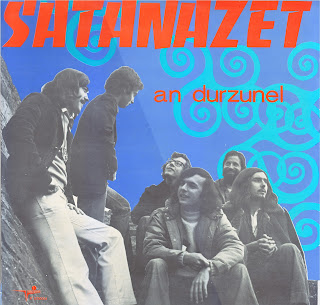APRES LA MAREE NOIRE
VERS UNE MUSIQUE BRETONNE NOUVELLE
AFTER THE OIL SLICK
TOWARDS A NEW BRETON MUSIC
Le Chant du Monde, 1979, LDX 74703
On the 16th of March 1978 the tanker Amoco Cadiz was adrift due to rudder failure. In spite of many rescue attempts, the tanker drifting towards the coast of Portsall finally opened its hull on the rocks. 300 km of coastline were polluted in the end; It took 6 months to relatively clean the area while the marine wildlife needed over 7 years to recover from the biggest pollution known in Brittany at the time. This catastrophy had also a political aspect : the mayors of the 98 concerned municipalities have joined forces to sue the oil company Standard Oil of Indiana and make them pay for the pollution. In 1992 the company was ordered to pay 225 million francs (around 34 million euros).
During the seventies many things happened in the Breton music revival generated by Alan Stivel among others. There was a desire to create others ways of expression like mixing traditional and jazz music.
Francois Tusques was born in Paris in 1938 and thanks to his parents he discovers jazz through concerts of S. Bechet, C. Luter or R. Urtreger. His career as a jazz piano player starts in the early sixties in Nantes and Paris. After May 1968 he's more and more politically committed and plays with singer Colette Magny. At he beginning of the seventies he thinks that French jazz is at a dead end and he creates the Intercommunal Free Dance Music Orchestra which brings together musicians from all backgrounds to present a less elitist style of jazz. This album is a good example of this approach to popular music. All the music is Tusques' works.
Among the musicians we find three traditional Breton bombard and biniou players, one Catalan singer and jazzmen like the Occitan Michel Marre or Jo Maka born in Guinea (1929-1981).
There is only one song ''Caball'' (the Horse) sung in Catalan by Carlos (Carles) Andreu which tells about the situation in Brittany after the oil slick when the local peasants had to collect fuel on the beaches for months. There is one line that sums up what the song is about : ''la llei del profit es la llei del progrès'' meaning ''the law of profit is the law of progress''. Andreu uses a vocal technique from the ''cuantre'' typical of Ibizza.
Most of the tunes are based on Breton ''gavotte des montagnes'' danced in Inner Brittany.
Text in French.

This album is now available on CD issued by SouffleContinu records in Paris









































